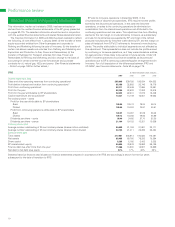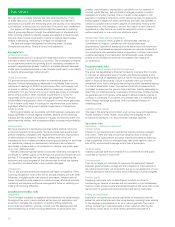BP 2006 Annual Report Download - page 20
Download and view the complete annual report
Please find page 20 of the 2006 BP annual report below. You can navigate through the pages in the report by either clicking on the pages listed below, or by using the keyword search tool below to find specific information within the annual report.ratio is expressed in oil equivalent terms and includes changes resulting
from revisions to previous estimates, improved recovery, extensions,
discoveries and other additions, excluding the impact of sales and
purchases of reserves-in-place and excluding reserves related to
equity-accounted entities. The proved reserves replacement ratio,
including sales and purchases of reserves-in-place but excluding
equity-accounted entities, was 11% (2005 40% and 2004 64%). By their
nature, there is always some risk involved in the ultimate development
and production of reserves, including but not limited to final regulatory
approval, the installation of new or additional infrastructure as well as
changes in oil and gas prices and the continued availability of additional
development capital.
In 2006, net additions to the group’s proved reserves (excluding
sales and purchases of reserves-in-place and equity-accounted entities)
amounted to 329mmboe, principally through improved recovery from
existing fields. Of the reserves additions through improved recovery from,
and extensions to, existing fields and discoveries of new fields,
approximately half are associated with new projects and are proved
undeveloped reserves additions. The remainder are in existing
developments where they represent a mixture of proved developed and
proved undeveloped reserves. Major new development projects typically
take one to four years from the time of initial booking to the start of
production. The principal reserves additions were in the UK (Devenick,
Foinaven), the US (San Juan, Seminole, Great White, Horn Mountain,
Mars) and Angola (Rosa, Greater Plutonio).
Total hydrocarbon proved reserves, on an oil equivalent basis
for equity-accounted entities alone, comprised 4,537mmboe at 31
December 2006, an increase of 17.2% compared with 31 December
2005. Natural gas represents about 14% of these reserves. The proved
reserves replacement ratio for equity-accounted entities alone was 272%
(2005 151% and 2004 114%) and the proved reserves replacement ratio
for equity-accounted entities alone but including sales and purchases of
reserves-in-place was 239% (2005 141% and 2004 170%).
Additions to proved developed reserves in 2006 for subsidiaries were
675mmboe, including sales and purchases. This included some reserves
that were previously classified as proved undeveloped. The proved
developed reserves replacement ratio (including both sales and purchases
of reserves-in-place) was 70% (2005 63% and 2004 70%).
Additions to proved developed reserves in 2006 for equity-accounted
entities were 936mmboe. This included some reserves that were
previously classified as proved undeveloped. The proved developed
reserves replacement ratio (including both sales and purchases of
reserves-in-place) was 195% (2005 99% and 2004 180%).
Our total hydrocarbon production during 2006 averaged 2,629 thousand
barrels of oil equivalent per day (mboe/d) for subsidiaries and 1,297mboe/d
for equity-accounted entities, a decrease of 3.3% and an increase of 0.1%
respectively compared with 2005. For subsidiaries, 36% of our production
was in the US and 16% in the UK. For equity-accounted entities, 75% of
production was from TNK-BP.
Total production for 2007 is expected to remain broadly the same as
in 2006 after allowing for the impact on 2007 of divestments made in
2006. This estimate is based on the group’s asset portfolio at 1 January
2007, expected start-ups in 2007 and Brent at $60/bbl, before any 2007
disposal effects and before any effects of prices above $60/bbl on
volumes in PSAs.
The anticipated decline in production volumes from subsidiaries in
our existing profit centres is partly mitigated by the development of
new projects and the investment in incremental reserves in and around
existing fields. We expect that this overall decline in production from
subsidiaries in our existing profit centres will be more than compensated
for by strong increases in production from subsidiaries in our new profit
centres over the next few years. Production in our equity-accounted joint
venture TNK-BP is expected to remain broadly constant to 2009.
The most important determinants of cash flows in relation to our oil and
natural gas production are the prices of these commodities. At constant
prices, cash flows from currently developed proved reserves are expected
to decline in a manner consistent with anticipated production decline
rates. Development activities associated with recent discoveries, as well
as continued investment in these producing fields, are expected to more
than offset this decline, resulting in increased operating cash flows over
the next few years. Cash flows from equity-accounted entities are
expected to be in the form of dividend payments. (See Liquidity and
capital resources on page 54.)
18
























